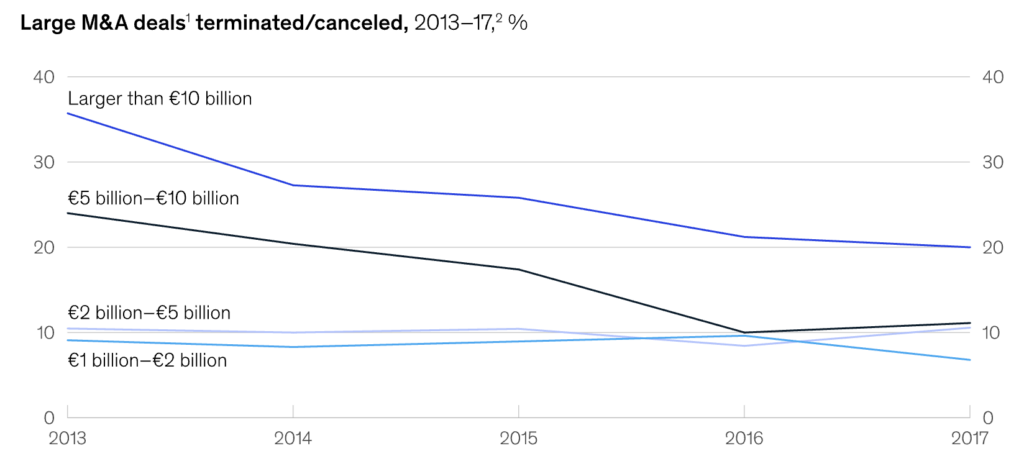About 10% of large mergers and acquisitions that are worth more than €1 billion are canceled every year, McKinsey states. This is truly a significant number considering that 460 of such deals are announced yearly.
Among the most common reasons for failure are poor cultural fit, lack of management involvement, unclear strategy, and inadequate due diligence, based on the Statista survey. However, there are many more risks that could significantly impact the deal’s success.
This article focuses on the main M&A risk factors that could ruin the deal and provides helpful tips on how to mitigate each type of M&A risk.
9 types of risks in M&A
Let’s take a closer look at the main risk factors of mergers and acquisitions and ways to reduce them.
1. Inadequate due diligence
Results of the Bain & Company survey show that 60% of executives attribute the deal failure to poor due diligence.
Due diligence is an integral part of the mergers and acquisitions process and the buyer’s chance to thoroughly investigate all the aspects of the target company’s operations to ensure it is worth investing. At the same time, inadequate due diligence can lead to unforeseen liabilities, missed critical financial issues, and operational challenges.
Note: Read more about mergers and acquisitions in investment banking in our dedicated article.
How to mitigate?
For poor due diligence risk mitigation, follow these simple recommendations:
- Assemble an expert team
To be able to notice and timely react to potentially risky issues in the documentation of the target company, you’ll need a team of professionals in many areas, such as finance, law, or audit.
- Establish a comprehensive due diligence process
Due diligence is adequate when it’s thoroughly planned, has a clear structure, and responsible people are defined.
2. Cyber risk
Based on the IBM report, the global average cost of data breach in 2023 was $4.45 million, which is a 15% increase over 3 years. What’s more, Forescout Technologies’ survey among more than 2,700 business decision-makers demonstrates that 53% of respondents experienced certain cybersecurity issues during an M&A deal that put the whole transaction at risk.
Indeed, cyber security is among the main concerns of deal-makers during mergers and acquisitions. This is what Pawel Wilczynski, a Cybersecurity Manager at Baker Newman Noyes, says about the possible consequences cyber issues can have for the deal and business in general:
Cyber threats can have severe consequences for businesses. A successful cyber attack could potentially lead to the theft of valuable intellectual property, exposure of confidential information related to the M&A transaction, monetary loss, damage to brand reputation, and legal liabilities. These consequences can be devastating for businesses, especially in the context of an M&A transaction. A cyber breach during the M&A process can derail the transaction, leading to significant financial losses and damage to the reputations of all involved.
How to mitigate?
This is how dealmakers can approach cyber risk issues:
- Forensic analysis
Companies can perform forensic analysis of the cyber risk accompanying an M&A transaction with the help of various bog-data tools. Such an analysis focuses on reputation and reliability and helps to detect risks that are typically not detected during standard due diligence.
- Insurance policies
Dealmakers can adopt certain insurance policies to lean on during the transaction that help to ensure a company will not be affected by any risky issues found during the deal.
- Virtual data rooms
To address breach risk, modern dealmakers often opt for using virtual data room solutions during due diligence. Virtual data rooms ensure the secure storage and distribution of highly sensitive or confidential data.
3. Target company’s overvaluation
Results of the survey by Statista show that 36% of corporate investors and 43% of private investors named deal valuation one of the leading factors in achieving M&A success in the United States.
Determining the fair value of the company is truly essential since the overvaluation of the target company can lead to overpayment and reduced return on investment (ROI).
In fact, the analysis of about 2,500 deals by McKinsey & Company between 2013 and 2018 shows that the larger the transaction, the more likely it is to fail.

How to mitigate?
To reduce the risk of M&A overvaluation, and, as a result, overpayment, follow these two simple recommendations:
- Use different valuation methods
To mitigate valuation risks, consider using several valuation methods simultaneously, such as discounted cash flow analysis, precedent transaction analysis, or comparable company analysis.
- Engage external specialists
To eliminate the risk of poor valuation practices, it’s recommended to engage external financial advisors. They can provide an unbiased perspective and reduce the risk of overpaying.
4. Integration challenges
Integration risk M&A is often underestimated. However, it’s among the top factors for M&A deal failure. Statista’s survey among M&A practitioners in 2021 shows that 41% of deals failed because of a lack of post-merger integration, including poor cultural understanding and a lack of trust between the buyer and the seller.
Merging two different corporate cultures, operational processes, and management styles can lead to conflicts, inefficiencies, staff turnover, and failure to meet the deal’s objectives.
How to mitigate?
To ensure a smooth post-merger integration, follow these recommendations:
- Create a detailed integration plan
At the early stages of the M&A process, create a post-merger integration plan with all the objectives, stages, and responsible parties clearly defined. It should cover everything from employee onboarding to financial reporting and IT systems. Explore how to create an acquisition integration playbook in our dedicated article.
- Get stakeholders involved
Assure robust communication between stakeholders from the buy- and sell-side, set realistic expectations, and communicate all the integration stages and timelines clearly.
5. Intellectual property risk
The World Intellectual Property Organization states that 2022 was a record year for patent activity: about 3.46 million patent applications were submitted around the world, which is a 1.7% growth compared to 2021.
The intellectual property valuation represents a potentially catastrophic risk in any M&A deal. Lewis Lee, a Global Head at Aon Intellectual Property Solutions, states that one of the biggest mistakes a company can make is to consider its intellectual property a legal instrument instead of thinking of it as a core asset to the business.
How to mitigate?
For intellectual property risk management, follow these recommendations:
- Conduct intellectual property due diligence
Intellectual property (IP) due diligence allows for assessing the quantity and quality of the target’s intellectual property assets, which, in turn, helps to set a fair deal value and potential.
- Engage external specialists
For a successful IP due diligence, it’s also recommended to engage third-party professionals in the field of intellectual property who have relevant expertise.
6. Tax risk
Ernst & Young’s 2019 M&A survey demonstrates that tax issues were cited as the primary reason for deal failure by 33% of respondents. The tax insurance market is now evolving to address the liability associated with a company’s uncertain tax position.
The deal-making is heavily influenced by changes in the tax environment that should be timely detected and addressed.
How to mitigate?
This is what the sell- and buy-side can do to mitigate the tax risk of mergers and acquisitions:
- Seller’s perspective
Tax issues can be reduced by the seller’s proper preparation of tax documents. Before approaching prospective investors, the selling company should also be aware of the tax burden that will be imposed on them as a result of the sale.
- Buyer’s perspective
An acquiring company should ensure thorough tax due diligence with responsible internal and external experts involved that will ensure the seller has all the taxes in order and regulatory compliance in place.
7. Unexpected extra costs
Often, the estimated deal value can substantially grow in the process of the deal. This is because of various extra costs that appear during the transaction, such as legal fees, advisor fees, investment banking costs, or regulatory penalties. For example, in 2022 alone, companies paid about $6.4 billion in penalties under 760 non-compliance lawsuits, according to the SEC.
How to mitigate?
To eliminate the risk of the deal’s value increase, follow these recommendations:
- Ensure quality planning
The best way to decrease unexpected extra costs is to perform comprehensive financial planning beforehand that will include all the possible costs that can appear during the M&A process.
- Opt for digital solutions
Usage of such digital tools as virtual data rooms can significantly reduce the risk of extra legal fees, as VDRs provide a highly secure space for confidential data storage and sharing.
8. Litigation risk
When a target company is facing existing or threatened litigation, it can not only bring potentially catastrophic damages to the buyer but also prevent a deal from happening at all.
This is what Elliot Konopko, former Senior Managing Director at Aon Litigation Risk Group, says about litigation risk in mergers and acquisitions:
Many buyers are not willing to take on this type of potentially catastrophic risk and sellers are looking to walk away cleanly. In the past two years, we’ve identified a substantial market for what we call judgments-only catastrophic insurance.
How to mitigate?
This is what matters in mitigating the litigation risk during M&A:
- Thorough due diligence
An in-depth and quality due diligence of financial statements and other documentation helps to identify whether the target company faces pending or possible litigation and thus, assess its impact on the future merger or acquisition.
- External expert engagement
Hiring external law and financial experts can significantly improve the due diligence process, and thus, help to mitigate the litigation risk.
9. Synergy overestimation
Miscalculating synergy risks also often puts risks on the deal’s success. Bain’s survey demonstrates that 55% of executives attribute disappointment in the deal’s outcomes to overestimated synergies. This is because companies often enter the deal with overly optimistic expectations without conducting a proper analysis.
How to mitigate?
To eliminate the possibility of synergies risk appearance during the M&A process, follow these recommendations:
- Perform a thorough synergy analysis
A comprehensive synergy analysis during due diligence helps to identify areas where operation improvements, cost savings, and revenue boosts can appear.
- Outline clear goals and milestones for synergy realization
This way, all deal participants will have a clear vision of what outcomes to expect from the deal, in what period of time, and what actions should be performed by every responsible person.
General risk mitigation tips
Besides the core recommendations on how to mitigate potential risks during mergers and acquisitions mentioned above, there are also several general tips for risk assessment:
- Opt for project management platforms
There are various digital risk mitigation tools that help plan and execute due diligence and other stages of the M&A deal. For example, virtual data room software offers a secure space for effective data sharing, collaboration, and project execution.
- Engage external experts
Often, the external expertise of third-party professionals is of great use. This way, you ensure that all the aspects of the deal such as legal, intellectual property, or financial are fully covered and addressed.
- Focus on planning
Comprehensive planning of the deal process is one of the keys to the deal’s success. Ensure all the goals, milestones, timelines, and responsibilities are clearly defined and communicated.
Final words
During the M&A deal, the sell-side and buy-side can face various M&A risks that can significantly impact the deal outcomes.
The most common types of M&A risks include inadequate due diligence, cyber risk, target company’s overvaluation, integration challenges, intellectual property risk, tax risk, unexpected extra costs, litigation risk, and synergy overestimation.
General recommendations for risk arbitrage in mergers and acquisitions include developing a comprehensive deal plan, engaging external experts, and using project management platforms.


